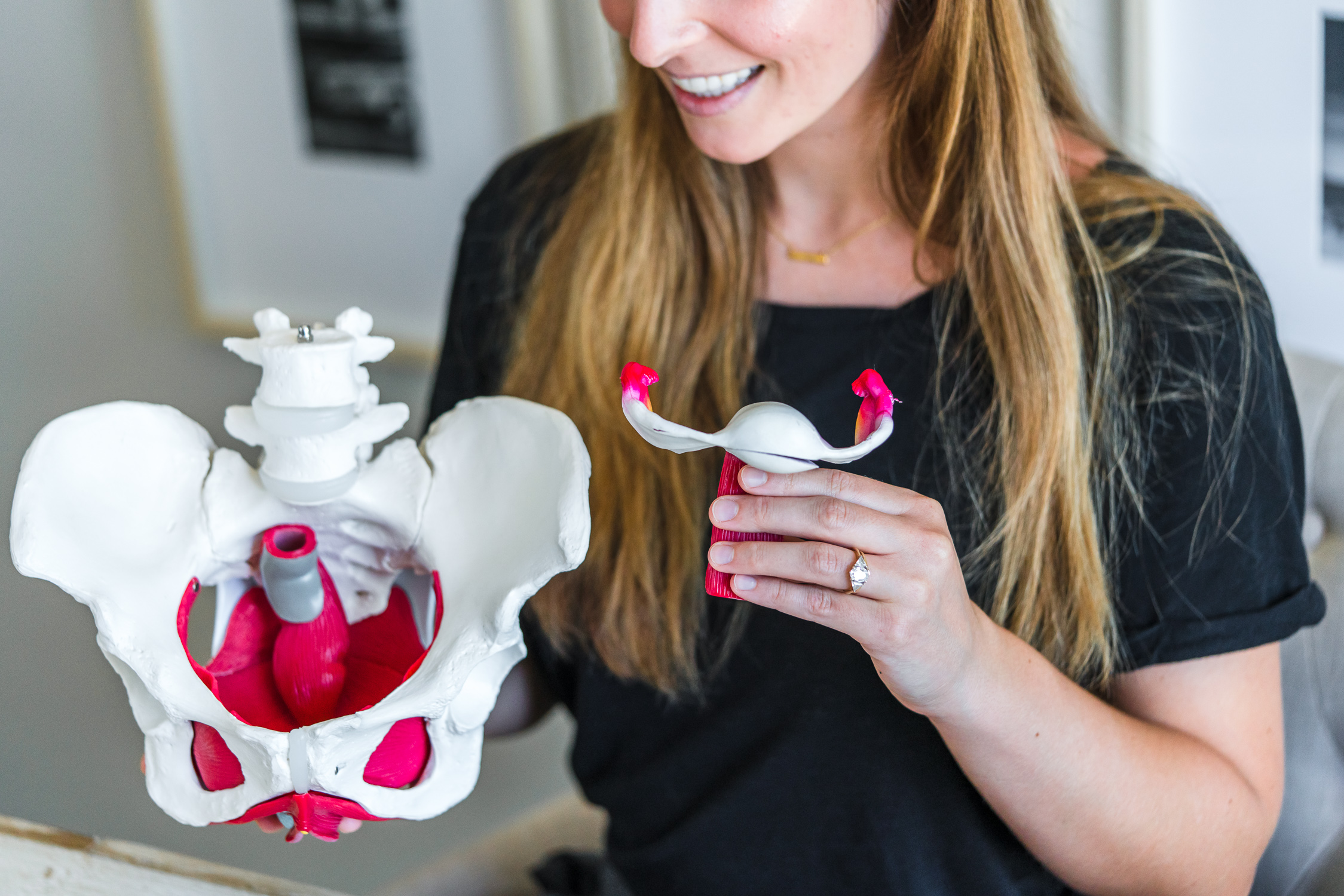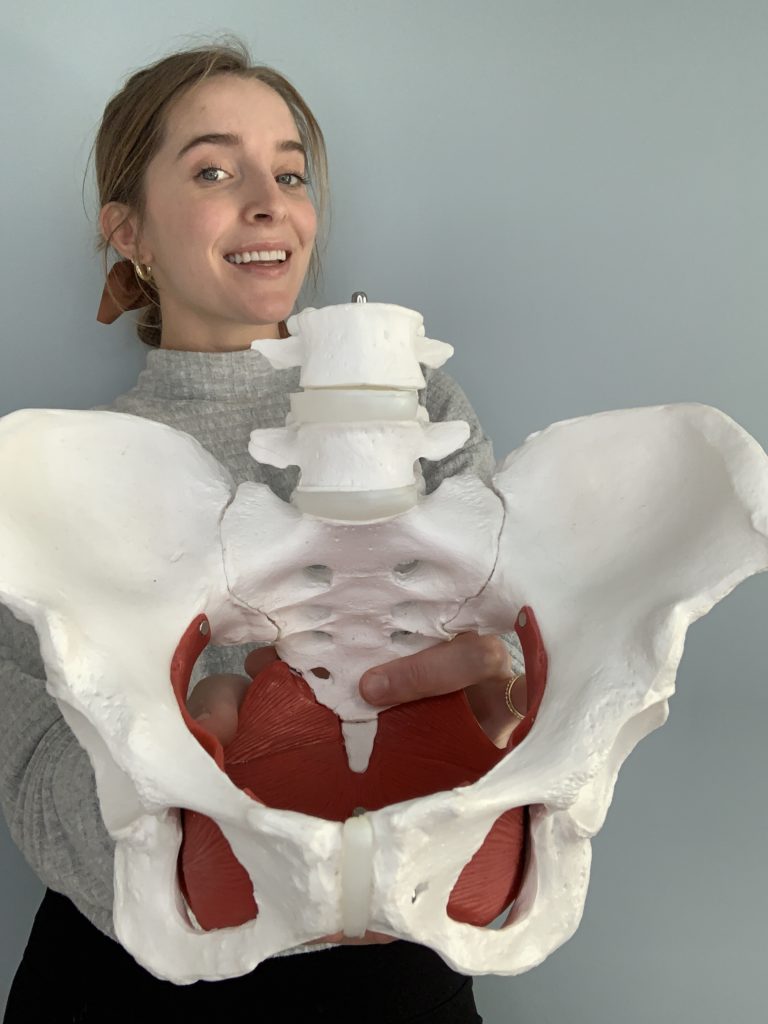Pelvic Floor 101: Back to the Basics

A common question I get as a pelvic physical therapist is, “what the heck is the pelvic floor and why is it important?!?”
I think the best way to answer this is bringing it back to the basics to discuss what is the pelvic floor, what are common (but not normal) dysfunctions, and ways specialized pelvic physical therapy can help… consider this Pelvic Floor 101!

What is the pelvic floor?
Okay, so first things first, the pelvic floor is the most overlooked muscle group in the body! In fact everyone has it and it is responsible for some of our main primal functions; pooping, peeing, and procreating.
The “pelvic floor” is a name used to describe all the muscles, ligaments, nerves, vessels, and connective tissue that stretch across the bottom “floor” of the pelvis. The pelvic floor spans from the pubic bone to tailbone, and sit-bone to sit-bone making a supportive hammock. This area is super important because it is truly the floor of our core. It connects our upper and lower body, and is the only thing between your internal organs and the ground, so it’s a big deal!
The pelvic floor has 4 major functions which are essential for daily life (the 4 S’s):
- Sphincteric: the pelvic floor is responsible for controlling the sphincters for bathroom use (urethra/rectum). Either contracting to keep you from peeing yourself or relaxing to let you have a bowel movement!
- Stabilization: it provides added support to low back and boney pelvis.
- Supportive: the pelvic floor supports ALL of the organs in our pelvic cavity (basically a hammock for the bladder, vagina, prostate, uterus, and rectum)
- Sexual: it is responsible for sexual functions such as arousal and orgasm (for both males and females)!

How can the pelvic floor become dysfunctional?
Try picturing the pelvic floor as a hammock. The hammock should be at the perfect tension level where you can sit/swing in it but, this hammock can also be too taught or too droopy where it then makes it difficult to sit/swing. In pelvic floor physical therapy we use this analogy to describe the muscle tension within the pelvic floor when assessing an individual:
Hypertonic pelvic floor: Taught hammock. Often connected to painful intercourse (sex), constipation, and male pelvic pain (testicular/penile pain), frequent urination, and more.

Hypotonic pelvic floor: Droopy hammock. Often connected with pelvic organ prolapse (where organs descend through vaginal canal), urinary incontinence, fecal incontinence, and more.

An estimated 1 in 5 people will have pelvic floor dysfunction at some point in their lives. It is important to be aware of signs/symptoms/risk factors of pelvic floor dysfunction. If left untreated, pelvic floor dysfunction is associated with depression, social isolation, anxiety and generally reduced quality of life.
Sign/Symptoms:
- Orthopedic conditions: low back pain, SI joint pain, tailbone pain etc.
- Pelvic pain conditions: chronic constipation, pelvic floor muscle spasm, painful bladder, IBS, etc.
- Pregnancy and postpartum: back pain/hip pain, SI joint pain, incontinence, pelvic pressure etc.
- Post-surgical care: C-section, hysterectomy, hernia repair and any other abdominal surgery
- Urinary conditions: incontinence, urinary frequency/urgency, recurring UTI’s
- Male pelvic pain: erectile dysfunction, testicular/penile pain, etc.
- Female pelvic pain: endometriosis, painful intercourse (dyspareunia), etc.
Risk Factors:
- Previous trauma to pelvis: Pregnancy/delivery (both vaginal and c-section!), fall on pelvis, car accident, cancer (prostate, ovarian).
- Increased abdominal pressure: chronic coughing/sneezing (allergies/smoking). Coughing puts more strain on your pelvic floor than lifting, running, jumping, or sit-ups.
- Increased BMI (over 25): obesity is heavily linked to urinary incontinence and pelvic pressure.
- History of low back pain: One study found 95% of individuals with low back pain have pelvic floor dysfunction.
- Constipation/heavy lifting: Constipation is caused but the lack of coordination of the pelvic floor muscles and increased intra-abdominal pressure while trying to have a bowel movement. This consistent pushing while attempting to defecate causes pelvic floor dysfunction. Occupations/individuals that perform constant heavy lifting have been linked to increased pelvic pressure and bladder conditions in both men and women.
- Prolonged vigorous physical exertion: Especially prominent in elite athletes performing high impact activities (running, jumping, olympic weightlifters).
How does pelvic physical therapy help?
Now this general description of the pelvic floor as a hammock is helpful but often over-simplifies what is causing the dysfunction. Just like all other areas of our bodies (the leg bone is connected to the hip bone…) the pelvic floor does not work in isolation. SO when dysfunction arises it is important to consider other factors that may be contributing to the hypertonic/hypotonic pelvic floor (taught/droopy hammock).
THIS is where the pelvic floor specialist comes into play!
Check out my previous blog on What is Pelvic Floor Physical Therapy for more details on how pelvic PT works for the above dysfunctions!

As always, if you have any questions or notice you have some of the above signs/symptoms please reach out to me or your local pelvic PT. I offer free 15 min consults and love helping you figure out a game plan if you resonate with anything stated above!
As for right now here are some of my favorite stretches/breathing patterns to practice for general pelvic health!
As for good tips/tricks for general pelvic health. Here are a few of my favs!
A few of my fav pelvic floor specific stretches include deep squat, child’s pose, and happy baby. Hold ea for 60 secs!
You can also try the below:
- BREATHE: practice deep breathing activities. Start by lying on your back, one hand on stomach and one on chest, inhale and let you stomach rise and exhale and let it fall.
- Avoid pushing with urination and bowel movements. Check out my previous blog on constipation on how to do this!
- Take a hot bath. It increases blood flow through the region and can help carry away inflammation.
- Try yoga, honestly with all the craziness in the world we all need a little more movement and mindfulness. All incorporated in yoga! My favs online are yoga with Adrienne and melissawood.
- Avoid prolonged sitting. When we sit too long we compress our pelvic floor including important nerves and blood vessels this is increased with risk on pelvic pain.
- Get out and walk. Walking is so important for increasing blood flow and decreasing stress get out and let your body MOVE.









